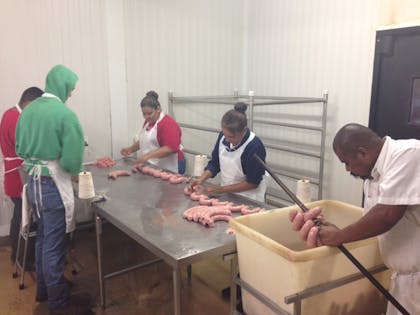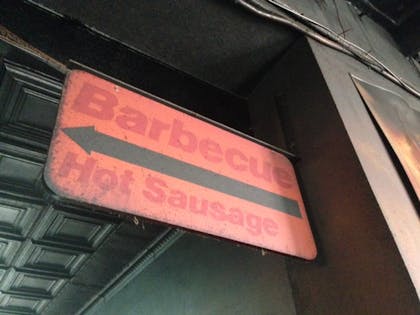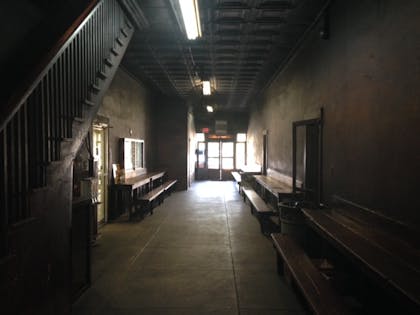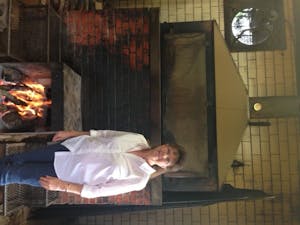 Owner: Smitty’s Market; Opened 1999
Owner: Smitty’s Market; Opened 1999
Age: 64
Smoker: Indirect Heat Wood-Fired Pit
Wood: Oak
There’s plenty more to Smitty’s Market in Lockhart (formerly Kreuz Market) than the family split that occurred fifteen years ago. Nina Sells grew up in this barbecue joint, and remembers a great deal of the family history. The building itself is a timeline of property acquisition. The original building was built in 1924, but if you’ve eaten there, it was probably in the dining room that was made part of the restaurant much later. Also, those stairs in the main corridor actually lead up to second floor dining room. There’s even a basement.
The improvements haven’t come to a standstill either. There’s a gym next door that will soon belong to Smitty’s. They plan to knock down the wall on the south side of the existing dining room and expand into the adjacent space.
While Nina Sells was a most congenial host during my visit where we toured the entire building, she had no obligation to be. Smitty’s had been in the top five of the previous two Top 50 BBQ lists that came before my tenure as barbecue editor. In the most recent list, Smitty’s wasn’t in the Top 50. This didn’t phase Sells. The first time we spoke after the list was released, she thanked Texas Monthly for everything they had done to publicize Texas barbecue. Now, that’s a classy way to handle a negative restaurant review.
Daniel Vaughn: When was this building built?
Nina Sells: This building here, the original barbecue place, was built in 1924. At least that’s what the glass said out on the front. It fell off and I have it at my house.
DV: We’re down in the basement. What is this room here?
NS: I was born in 1950, and I never remember this being used as a smokehouse. I’m sure it was used for smoking at one time in this building’s early life but I don’t remember it, it was all done outside.
DV: You can really smell the smoke. It’s definitely in the walls.
NS: Now it’s a getaway and sometimes the employees do take a break to get away from barbecue.
DV: When Kreuz Market first opened, what building was it in?
NS: It was in a building that was on this lot. I’ve never seen a picture of it. Texas Monthly had a picture of a meat market area that was an early Kreuz Market, but I wasn’t here.
DV: Do you have any idea if the Kreuz family was the one to build that building, or did they just take over the original one?
NS: I don’t know. In 1899 when it supposedly first developed into Kreuz Market, obviously the people running it were the Kreuz family. And that would’ve been Teddy and Mr. Molly, their father.
DV: Did you know them growing up?
NS: Two of them, Mr. Molly and Ms. Clara.
DV: And, your father, Edgar Schmidt, bought the business and the building from them?
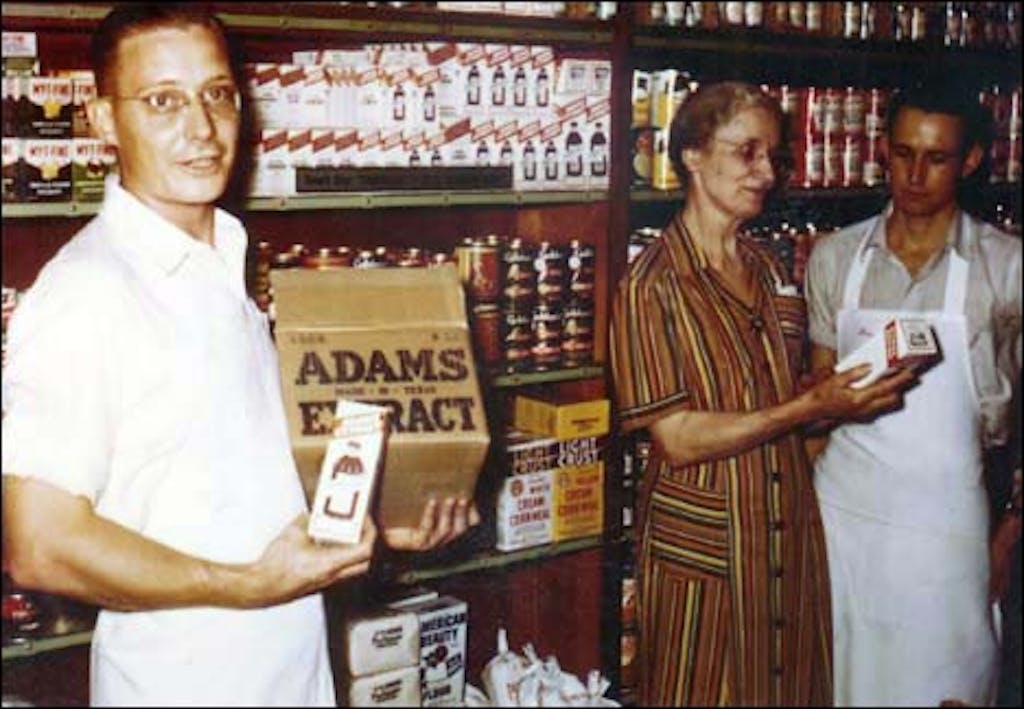
NS: Yes. In 1948.
DV: Where was the market itself when he purchased it? I’m assuming it wasn’t where the dining room is now.
NS: No, that wasn’t acquired until 1978.
DV: So in the ‘70s you bought the buildings to the north and south?
NS: Right. In the original 1924, this is where the sausage was made. You can tell where the Waterpress sausage stuffer was and there were these long tables. Sausage would come and was cooked on those cookers here and outside. Where the restrooms are, that was pits also.
DV: Because the restrooms at that time were outhouses?
NS: That was the men’s. The ladies had to go upstairs. Dad purchased that lot [to the north], tore the building down and moved sausage production to this building here.
DV: And the sausage is being made right now?
NS: Yes, it is. They get it together here and then it goes to the stuffer, he stuffs it, and then they hand tie it.
DV: What seasonings go in it, unless they’re secret?
NS: No. Salt, black pepper, and red pepper.
Man at the grinder: And here’s our binder.
DV: Is that bull flour?
Man: It is, yes.
NS: So they’re not gluten-free.
DV: How much sausage do you make in a day, do you know?
NS: It varies. They started making them I think on Monday, Thursday, Friday, and usually on the weekends too.
DV: [to man] Do you know how much sausage you make in a week?
Man: Too many. About 3500 links a day.
DV: Where did that sausage recipe come from?
NS: It’s just one that’s been passed down to us through the Kreuz Market family.
DV: So this is where the sausages are smoked?
NS: Yes. There’s a thermometer, but I don’t know how much he relies on it. He just looks at it and sees where the little drip is and how it’s cooking. They are turned once in the process.
DV: When they go on here, is this their final step?
NS: This is the final step for cold sausage. The final step for the hot is on the pit. This is what I think makes us different than the other barbecue places. I don’t know how they’re cooking their sausage; I would assume most of them don’t do it like this.
DV: Most of them aren’t cooking them in anything that’s strictly wood-fired too.
NS: It takes more manpower, because they’ve got to constantly watch it, but we’re going to do it the old-fashioned way as long as we can.
DV: Do you think that’s your most popular menu item?
NS: The sausage? Yes the sausage and the brisket.
DV: Do you know who built these pits? You said that this was the 1924 building.
NS: These pits were reworked in ’78 when Dad bought the building next door. This wall is the back of that old general dry goods store that’s next to it, and this was added on. This is original, from 1924, and if you start right here, this is 1978 building, that and the restrooms that go behind this.
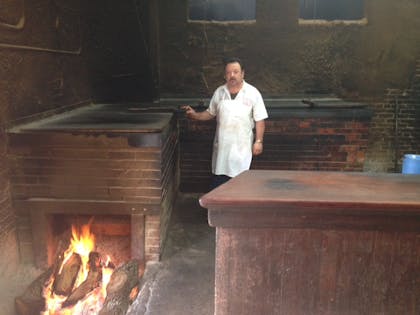
DV: This pit here, you said that it’s been reworked a bit, but have the fires always been at the end?
NS: Yes. This is the original counter. It was left here and the pit was the same way, we just had to rework the brick on the outside because it was starting to fall off. They do get hot, especially on the weekends it gets pretty hot—lots of coals.
DV: Is this pit just for overflow?
NS: For now, yes. We don’t keep those open until Thursday or Friday. Dean will be in charge of them.
DV: Who or what group of folks is considered the pitmasters here?
NS: Dean would be one. He tends to this. And then there’s Pablo, he’s really our main pit guy.
DV: [To Pablo] How hot does the pit normally get?
Pablo Garcia: I have no idea. We just go with it.
DV: How do you know when to put more wood on?
PG: It gets cold in here, so we put more fire on.
DV: Are any of these pits known to be hotter than the others?
PG: Pretty much all of them run at the same temperature.
DV: What’s your favorite item on the menu?
PG: Shoulder.
DV: You still eat barbecue?
PG: Oh yeah, every day.
DV: So the shoulder clod, how popular is it compared to the brisket?
PG: It’s in there.
DV: Do you use the same seasoning for the sausage as your rub?
PG: Yes, it’s the same salt, black pepper, and red pepper.
DV: How long have you been working here?
PG: Since ’99, when we opened, but I was here when Kreuz was here.
DV: So you worked here when it was Kreuz Market; do you remember when you started?
PG: I’m going on about eighteen or nineteen years here.
NS: So you were here 3 or 4 years before we opened.
DV: How much longer do you have in you?
PG: I don’t know. A couple more years though. I haven’t given up yet.
DV: I know you put a glaze or a sauce on the ribs. Do you know when that started?
NS: When we started ribs we glazed them. You know I can’t remember how many years ago that was, Pablo was it 8 years?
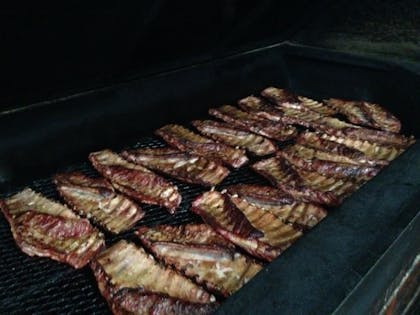
PG: Something around that.
DV: What date did you open, do you remember?
NS: I think it was the 21st or so of September [1999]. They moved out on the last day of August, and then we opened up.
DV: There’s talk in barbecue about grandfather clauses and things like that. Was it a hassle to have to open a brand-new business in an existing building?
NS: There are things we had to do, but I had a little leverage on them because I was already the owner of the building. I had been the owner since dad died in 1990, so for nine years. That gave me a little bit, but there were still things we had to do.
DV: Let’s talk about the menu. Do you remember as a child what the menu was in the barbecue joint?
NS: It was basically the sausage and pieces of meat but no pork ribs. Some of the meat would be cuts that were a byproduct of the meat market up front.
DV: So it wasn’t about, ‘well we’re going to do brisket and shoulder clod today,’ it was about what was left over in the meat market?
NS: Right. ‘We’re butchering this and we need this much of the brisket,’ or whatever the cuts were, because there has been that discussion of when brisket actually started. You’re talking to someone who is not old enough to know exactly when that brisket became an item. I just remember barbecue, and it looked like clod. It didn’t look like brisket. Some of it did because it was a thinner cut, but it was products of what came out of the meat market and the butchering process. When I was young they butchered out here east of town at the old Kreuz slaughter plant.
DV: So Kreuz had their own slaughter plant?
NS: Exactly. It was shut down in the early ‘70’s. Most of the small butchering processing places had a hard time complying with state regulations. We would have half-carcasses rolled in.
DV: And those half-carcasses would be used to stock the meat counter and the barbecue pit and the sausage grinder and all of it?
NS: Right.
DV: Do you remember if you ever used old bull meat for sausage?
NS: Sure. We had to butcher bull to get that leaner cut to add to it, or it would’ve been too much fat content in the sausage.
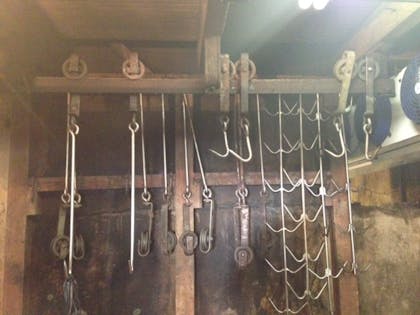
DV: So when you took over the business, do you remember what the menu was then?
NS: It was the same, except we did not have the pork ribs or the turkey breast, but basically it was the same. We had pork chops, lean and fat, and sausage.
DV: Was there anything that you changed from the Kreuz Market menu when you opened?
NS: Early-on, the beans. We added the beans, and we did that because it’s my dad’s recipe. He tore off a piece of butcher paper one day and he wrote the instructions for the recipe down for me and, being the keeper of records as I’ve been all my life I kept that. I pulled it out and the guys made a pot of beans and that’s what we’ve been cooking ever since. They are made from scratch. They pick them and clean them and soak them.
DV: It’s not often you find that.
NS: Well it’s easier and it’s probably cheaper the other way—you don’t have to have employees sitting and picking beans and cleaning them. It’s the same way with the sausages. There’s probably a cheaper way to do it, but as long as we can we’re going to do it the old-fashioned way that’s been done here at Smitty’s.
DV: Were there any side items when it was Kreuz Market?
NS: Well they didn’t call it side items, but they had tomatoes and onions and pickles, but that was it.
DV: But no prepared sides. What do you have now?
NS: We have beans, potato salad, but it is bought, the slaw we do make but it is packaged, but we do mix it—we put our own mix on it. Then we have the normal cheese, avocado, tomato, pickles. We haven’t added anything new to that.
DV: You have barbecue sauce too, right?
NS: We do. It was developed by the guys by trial and error when we first opened up to see what we wanted to do. There was such a request for it, but the building was a no-sauce-no-sides building, so we kind of hid it for a while.
DV: Were you almost relieved when you could start adding these things? Rick still doesn’t allow them down the street [at Kreuz Market].
NS: Well we didn’t allow them, we just waited until someone asked who really wanted it. We kept it in the cooler and if they asked for it, we gave it to them. It became so popular that now it’s not even questioned—yes, we do have the sauce. The hot sauce still is and was part of Kreuz, they always had the Texas Pete hot sauce, it’s always been the tradition, or at least it was when I remember. It’s not called a sauce though, not a barbecue sauce.
DV: The barbecue sauce is still something that you have to go up to this counter and ask for though, right?
NS: It’s there if you want it, and if you don’t want to have any part of it because you’re a traditionalist, well you don’t have to ask for it.
DV: Do you eat your barbecue with sauce?
NS: I’ve always been a ketchup person.
DV: Ketchup on your barbecue?
NS: No, not ketchup on barbecue, but French fries and ketchup, so sauce does not bother me at all, I like sauce, I think it adds to it. I agree that most say you can cover up bad barbecue with it, but I don’t think that’s the case here.
DV: You said it was 1948 when your dad bought the place. Was he buying a barbecue joint or a meat market?
NS: All of it, the buildings and business.
DV: So it had a reputation as a barbecue joint by the time you purchased it. Do you have any idea when that transition happened while it was Kreuz Market? I would imagine when they first opened it in 1900 they opened it as a meat market.
NS: Right, with the byproduct which is now the main product. All I’ve heard about it is they delivered. It was a small-town grocery store, so they delivered, and they had poultry delivered too. That’s about all I know. And that they were a very giving family; even during the depression they kept a lot of people with a little bit of food on the table.
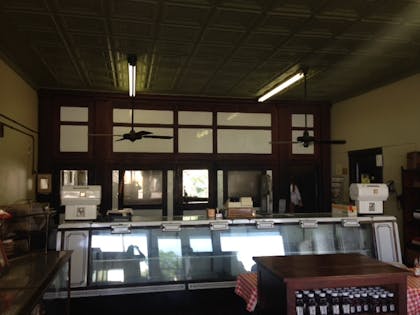
DV: Did your family shop at Kreuz Market?
NS: You mean before ’48? I don’t know. I know my grandfather, who worked as a butcher, had cut his thumb off. The thumbnail was like a little claw because it had grown back like that, and he always told me that a bullfrog bit his thumb off, and I always believed him.
DV: Was that in Lockhart?
NS: I would assume so, yes. But like I say I’m the youngest of the kids. Rick would have 5 ½ to 6 years of age on me, so he might remember the answer to those questions. Don probably would, too. I just knew he was a butcher. I assumed he worked here, but it could’ve been someplace else.
DV: Do you know how far back your family goes in Lockhart?
NS: I would say the first family member to move here was my great-grandfather from the Schmidt side. I would assume we’re fourth or fifth-generation Texans. All our relatives landed in Indianola and migrated toward the New Braunfels and the Lockhart area.
DV: When you were growing up, did you think of yourself as the daughter of a meat-market owner or a barbecue joint owner?
NS: It was barbecue joint owner. It was all about the barbecue. That was the moneymaker for him. The meat market is still in existence, but even back when I was young it was hard to compete with the big-name grocery stores. I married and went overseas and in ’72 when I came back the grocery store was gone. My dad said that he just couldn’t compete.
DV: I’m guessing you spent a lot of time in this building. Did you get sick of eating barbecue when you were little?
NS: Not really, no. In fact, when I was on the yearbook staff my senior year of high school we would leave and come down to the pharmacy to get pictures developed for the yearbook and we’d always swing by here. We’d get back to school and the teacher would say, ‘I smell barbecue again,’ so she knew that we had been to the pharmacy but we also made another stop. Dad would always cut us a slice and put it on crackers and we’d go out the door again. It was a part of my life.
DV: Did you ever work at the market before you took it over?
NS: There were times that I was in and out and I did work. I was going to school and I worked there part-time, but I never was back here in the pits. They didn’t trust me. That was early on in my life, that’s when my kids were still little when I worked that end. It was fun.
DV: You’ve had some employees since you opened, but some who were part of Kreuz Market before as well. Which employees have been here for a long time?
NS: Pablo Garcia is the cook and he was with Kreuz Market before we opened Smitty’s. He’s been with us since we started this operation. He’s very faithful, very loyal, always here and very dedicated to his job. I don’t know of any others who were Kreuz employees. There’s Jerry, his brother works at Kreuz, so that communication line is there. They know each other. We’re in this business in a small town together. Not too much happens at one barbecue place that the other doesn’t know about eventually, good or bad.
DV: You still live in Lockhart, right?
NS: Right. I’ve lived here all my life. I was born in Mumford Hospital when we had a hospital, it’s now a senior citizen’s center.
DV: So you said you have one employee who originally worked at Kreuz and stayed over. This interview isn’t about a feud, it’s about the history, but there was a split there. How did that work with the employees? Did you talk with some of them and try to keep them on, or did you try to build a staff of your own?
NS: Both, if they had an interest in staying with the building or the business. But I can’t think of any problems that existed about that. There was one employee who started out with us who decided Kreuz would be the better fit for him, but I don’t even know if he’s still there. I don’t know what to tell you about that. The employees are the ones you should probably ask because that communication line is there.
DV: Did your son come on as the pitmaster right when you opened?
NS: Yes.
DV: So John was working here in 1999.
NS: James and John both did, yes. Then James moved on and went to Bellville and worked in a meat plant there and did very well. John needed a break, so John’s taking a couple years to chill. He worked very hard here and then when we went to opening on Sundays, which was probably about four or five years into the existence of this, he just needed to get away for a while.
DV: And he helped open up Schmidt Family Barbecue, correct?
NS: Right, and I think he’s just not into barbecue right now. He says, ‘not yet,’ I asked him the other day if he was ready to come back because the boys can alternate. Nobody wants to be here seven days a week because that’s just too much, from 7:00am to 6:00pm every day, and then if we go to even longer hours in the evening, that’s a lot. John did it for many years, and we really appreciate it. I had my own job at the courthouse and Jim had his at the school, and John was the one who kept it going here. He was the hands-on in the business.
DV: James works here now?
NS: Yes. He moved here about a year ago, so it’s worked out well. I wish all families could get along, but it isn’t practical.
DV: Well call it a feud, call it a disagreement, but that split helped put Lockhart on the map.
NS: Now I don’t take credit for that. And I mean that in a good sense, because if it wouldn’t have happened, I don’t know where we’d be.
DV: The year that you opened Smitty’s, 1999, that was the same year that Lockhart was named the barbecue capital of Texas, correct?
NS: It was about that time. It was before Smitty’s, because we weren’t in on that, it was the three, Kreuz, Chisholm Trail, and Black’s. I was aware it happened, but we hadn’t even opened.
DV: I think part of what makes Lockhart so remarkable is that it can support four, and now five, barbecue joints with Mad Jack’s. Roy Perez from Kreuz says he goes to Chisholm Trail for a chopped beef sandwich every once in a while. Do you ever visit the other barbecue joints in town?
NS: You know I used to go there [Chisholm Trail] too to get vegetables before Smitty’s, but after that you kind of feel like you’re deserting or something, because there’s always a line, and one of the locals ladies said, ‘I am surprised to see you here in this line,’ and I said, ‘peach cobbler. Smitty’s doesn’t have peach cobbler.’
DV: Well do you ever go out and eat barbecue anywhere outside of town?
NS: No. Jim and I like to take off in the morning and come back the next night, to just spend one night away someplace, and there was a barbecue place in I think it was Navasota, but we didn’t stop. We never did. I remember when we were young we had to go to Ohio to go to my brother’s wedding and every barbecue place we would pass my dad, Smitty, would recognize, and he would holler, ‘BARBECUE!’ And he hollered ‘barbecue’ all the way to Ohio and back, because we passed a lot of barbecue places. So if you’re in the barbecue business, you do notice another barbecue place. If you’re thumbing through a magazine and ‘barbecue,’ is on the page, you’re going to stop and read it because you’re in the business and you want to know what’s going on. So when we go out of town we got to a Red Lobster every once in a while, but we never go to the barbecue places.
DV: Have you gone to Schmidt Family Barbecue?
NS: No, I have not. I haven’t been up there to eat, I’ve been up there to deliver brick and be the support group but I’ve never gone to actually eat.
DV: So does the pit there have one of the bricks from here?
NS: Yes. I don’t know how many, but I took them some of the old brick and some of the new brick—the ’78 was new brick.
DV: So you’ve got Black’s opening up in Austin and San Marcos, Kreuz is going to be opening up in Bryan. Is there another location in Smitty’s future?
NS: Has it been thrown out for consideration with us family members? Yes, it has.
DV: Do you feel any pressure to expand or get over to Austin? For a long time Austin was the place people stayed over to get out to Lockhart, and now it’s getting its own barbecue scene. Do you see that affecting your business here at all?
NS: No.
DV: Still as popular as ever?
NS: Yes. We have new people coming in and old people who have been coming in for years and years. No, probably wouldn’t be a consideration—us opening another barbecue place.
DV: Last time I was here I had an incredible slice of prime rib. When did you add the prime rib to the menu?
NS: It’s been there, but I just didn’t mention it a while ago but it’s been with us, but we don’t do a whole lot of it, and we run out during the lunch hour because it’s not something we want to keep on the pit for a long time.
DV: When is the last time you had to raise the prices?
NS: We just raised them. The wholesale price of meat has gone up and we held out and held out…it went from $11.90 to $12.90.
DV: When do the doors open?
NS: We open the doors at 7 and we do that because sometimes there are people who work in Austin who like to get cold sausage to go. Pablo’s going to be here at 7 anyway, so we just open the doors.
DV: What time do you start the local menu?
NS: Usually at 9:30 or 10.
DV: So I need to get your barbecue week plate if it’s all going to be ready.
NS: Jim put that on the menu yesterday and we thought, ‘nobody’s going to order this,’ but we sold thirty plates yesterday. He was totally amazed—30 plates in one day! Normally we don’t sell food by the plate.
DV: Exactly. Maybe people just saw the novelty in the fact.
NS: That was on a Tuesday!
DV: Well you’ll get one from me, so we’ll get it started out right.
NS: All right.
DV: Well now I have to ask you the most difficult question because it involved me and my magazine and Smitty’s, but for many issues you were in the top 50, and in this latest issue you weren’t. What were your thoughts when you heard about that?
NS: Well your first reaction is you’re disappointed. What can we do to improve it, is what I said. We met with the employees and said this is what is occurring and we know that we want to do whatever we can to try to change that. They understood what was happening, and we went from there. What can you do? We just made a few changes and we’ll keep on plugging.
DV: Well Smitty’s is one of the coolest places to come eat barbecue in Texas.
NS: Back on the Top 50, I thought we were just totally out and then y’all kept sending us invitations to be a part of things, and I finally asked the young lady who called us why we were getting these, she said, ‘oh, you’re an honorable mention.’ I must have missed that?
DV: The honorable mentions didn’t get printed in the magazine this time around, they got put on the website instead.
NS: Well, we survived.


